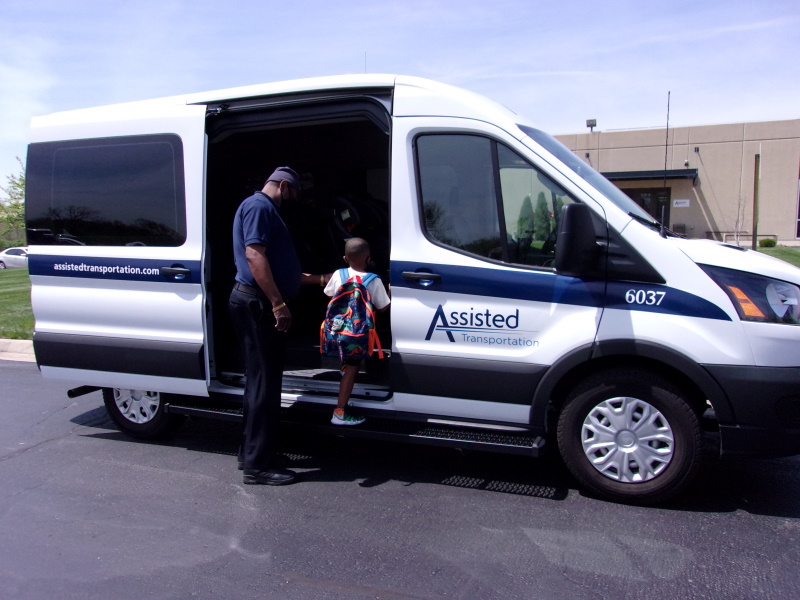Why school districts are choosing to supplement their yellow bus fleets.
In recent years, more and more school districts and traditional yellow bus contractors are seeing the need to supplement their student transportation services with alternative options for their special needs and general education population.
What is Alternative Student Transportation?
Alternative student transportation is a fleet of smaller vehicles, operated by trained drivers and aides, to transport students with special needs to and from school. These vehicles, sometimes called white fleets to differentiate from traditional yellow buses, are often vans outfitted with specialized equipment to accommodate students with disabilities.
Who Needs Alternative Transportation?
According to recent statistics, approximately 15% of public school students in the United States receive special education services under the Individuals with Disabilities Education Act (IDEA). IDEA establishes transportation as a legal requirement for students who qualify for special education, no matter how far those students live from their school. Many school districts have consolidated their specialized programs into one or two schools district-wide, which means a student may travel many miles to attend their assigned school.
Additionally, many IEPs require districts to provide alternative transportation as accommodation for students with disabilities. This could be as simple as a smaller capacity vehicle to accommodate children with autism or other sensory disorders, but it could also mean providing vans with wheelchair lifts or specialized safety equipment.
Students receiving special education services are not the only ones who may need alternative forms of school transportation, however. The McKinney Vento Act, which provides federal protections for students experiencing homelessness, states that districts must transport these students from wherever they are living to school. It also allows students to remain in the school they began in, even if their housing situation has moved them outside the boundary of that school.
Others who may need alternative forms of transportation include students attending after school programs, early education children who may need smaller buses with age-similar peers, and out-of-district rural students.
As you may imagine, school districts are finding that servicing these students is becoming both cost and time prohibitive. High fuel costs due to longer routes with mostly empty buses, the cost of retrofitting buses with lifts, booster seats, or specialized safety belts, plus a shortage of drivers and aides have made it nearly impossible for traditional yellow bus operators to meet the unique transportation needs of every student.
Limitations of Some Outsourcing Solutions
Faced with these challenges, some school districts have considered outsourcing their alternative transportation to taxi cabs or Transportation Network Companies (TNCs). While these options may seem cost-effective, they come with significant drawbacks. TNCs, who hire drivers as independent contractors in a model not unlike Lyft and Uber, cannot always guarantee they will have vehicles equipped to handle students with physical limitations. Moreover, drivers are not always adequately trained to manage medical emergencies or provide the level of care required by special needs students.
This lack of specialized equipment and adequate training raises serious safety concerns for both parents and school administrators. And what happens if a driver needs to take time off for illness or emergencies? Families and district personnel often complain about their inability to rely on rideshare drivers to provide consistent transportation for their most vulnerable student population.
Between financially and operationally over-taxed yellow bus providers, and the safety and reliability concerns of TNCs, there is a clear need for more safe, efficient alternative transportation options.
The Role of Alternative Transportation Providers
Premiere alternative transportation providers like ASTP partner, Assisted Transportation, offer a solution to these problems.
With their state-of-the-art vans and specially trained drivers and aides, these providers are equipped to handle a wide range of needs – both from students and families, and school and district administrators. By partnering with alternative transportation providers, school districts can ensure that their students receive the highest level of care and safety during their commutes.
Benefits to School Districts & Yellow Bus Providers
Whether a school district handles student transportation in-house or outsources to a yellow bus provider, there are many advantages to partnering with a full-service alternative transportation provider.
- Cost Efficiency: While the initial cost of contracting with alternative transportation providers may be higher, the long-term savings are substantial. Specialized providers reduce the need for expensive retrofitting of yellow buses and minimize the risk of costly incidents and accidents. Additionally, the efficiency of specialized routes can lead to reduced fuel consumption, fewer paid driver hours, and less fleet maintenance.
- Enhanced Safety and Reliability: The rigor and quality of driver and aide training provided by an alternative transportation company ensures that students receive the care they need, and offers peace of mind to parents and administrators. Additionally, the vehicles used by alternative transportation providers are designed to meet the highest safety standards, reducing the risk of accidents and ensuring a secure journey for students.
- A True Partnership: A full-service alternative transportation provider offers a true partnership with their clientele. Before the contract is even signed, every effort is made to learn district operations and come alongside them in a seamless integration. Where most TNC contractors come from a medical or taxi/rideshare background, white fleet companies like Assisted Transportation come from a yellow bus background. (Assisted has 60 years of combined yellow bus experience in their administrative office alone.) This experience allows them to “speak the language” of school district administrators, and truly complement their existing services.
- Operational Relief: Driver shortages are a real threat to the operational success of almost every transportation provider these days. By supplementing with alternative transportation providers, districts and yellow bus companies can focus on more efficient use of their resources, greatly relieving the strain on their already taxed drivers. This collaboration reduces the reliance on yellow bus fleets and their drivers and ensures that they can continue to provide reliable service to the majority of students.
The collaboration between traditional yellow bus providers and alternative transportation services represents a promising evolution in school transportation. By leveraging the strengths of both systems, school districts can offer a comprehensive and adaptable solution that meets the diverse needs of their students.
Contact Us
American Student Transportation Partners (ASTP) is committed to meeting the individual transportation needs of the students and districts we serve. We’re driving the future of student transportation by providing access to education through safe, dependable student transportation programs. Exceptional bus operators and alternative transportation providers choose ASTP because of our innovative approach to partnership, as well as the resources we provide to help “future-proof” their operations.
To learn more about partnering with ASTP, contact Nick Tierno, Director of Corporate Development, at ntierno@astpartners.com.

